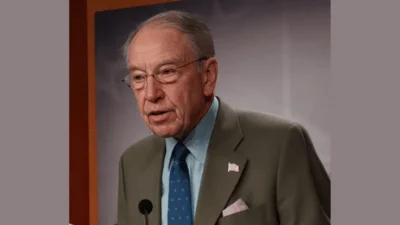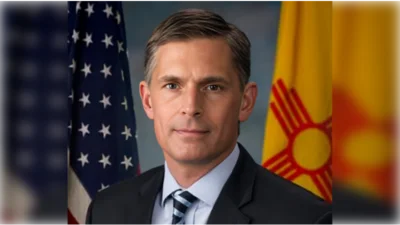The Congressional Record is a unique source of public documentation. It started in 1873, documenting nearly all the major and minor policies being discussed and debated.
“MEXICO IS A LENINIST STATE” mentioning the U.S. Dept of State was published in the Senate section on pages S6745-S6748 on May 16, 1995.
The publication is reproduced in full below:
MEXICO IS A LENINIST STATE
Mr. MOYNIHAN. Mr. President, in late January I came to the floor to speak of our relations with Mexico in the context of the new North American Free-Trade Agreement. My remarks appeared in the Record under the heading ``Free Trade With an Unfree Society.'' I returned to a theme which I had stated on a number of occasions since NAFTA was first proposed during the administration of President Bush. I had been an enthusiastic supporter of the free-trade agreement with Canada, but was troubled by the thought of a similar arrangement with Mexico, and for the most elemental reason. I argued that the political and legal arrangements of the United States and Canada being essentially symmetrical, the vast involvement in one another's affairs, the partial ceding of sovereignty implicit in such an agreement would provide quite manageable. There would be no political loss and considerable economic gain. Optimality, as an economist might say. By contrast, I feared that our political and legal institutions were anything but symmetrical with those of Mexico. Mexico, I said, was a Leninist state.
I had hoped for some response to this statement from the executive branch, but there was little. Indeed, apart from a gracious note from our distinguished Treasury Secretary, Robert E. Rubin, there was none. In any event, we were then, in January, caught up in an intense effort to save Mexico from defaulting on its foreign debt. This was the first of what I fear will be a sequence of such crises, and it seemed gratuitous to press the argument in that atmosphere. But now the first crisis has eased, thanks in large measure to what Alexander Hamilton, our first Secretary of the Treasury, termed ``energy in the executive,'' now embodied in his successor, Secretary Rubin. And so I would take this quiet morning to return to the subject.
I would begin by calling attention to an essay by William Pfaff, which appeared in the International Herald Tribune on March 16. Mr. Pfaff, who writes from Paris, is a foreign policy analyst of unexampled range, depth, and experience. He would be such if he lived in Utica, but living abroad gives him a singular perspective on American affairs. His essay begins with this simple, chilling analogy.
The commitment the United States now has made to Mexico bears a distinct resemblance to the commitment it made to Vietnam during the late 1950s and the early 1960s, when the troubles in that country were only beginning.
That was war and this is peace. Nonetheless now, as then, with as little reflection and a simplistic ideology, Washington has taken on responsibility for the fortunes of another nation that it scarcely knows and fails to understand.
In Mexico this American assumption of responsibility is primarily economic, but Mexico's economic plight is inseparable from the political crisis afflicting the eleven-decade-long dictatorship in Mexico of the PRI, or Institutional Revolutionary Party, historically the vehicle of Mexican nationalism--and of resistance to American exploitation of Mexican oil resources.
Washington has demanded, and last Friday was given, Mexico's promise of a program of economic austerity with distressing implications for millions of Mexicans, who only weeks ago were being told that their country's membership in NAFTA assured rising prosperity for them and their country. One aspect of the new arrangement is that a major part of Mexico's future oil revenues is pledged against the new American and international loan guarantees.
Even without the debt crisis a national upheaval is under way in Mexico which not even the Mexicans can be sure they can solve. Washington's commitment to a solution is an engagement with the uncontrollable and unforeseeable.
In my January statement I was unapologetic about discussing government in the abstract. I allowed as how Speaker Gingrich, by encouraging us to read or re-read The Federalist, was directing us to just such abstractions, which very much engaged the Founders of the Nation. They ransacked history for different ideal types of government for lessons to be learned and contrasts to be made with the new American Republic which they had set about constructing. Here, then, is a definition of Leninism from the ``Harper Dictionary of Modern Thought.'' The capitalized words are employed in the original for purposes of cross reference:
Leninism. The term refers to the version of MARXIST thought which accepts the validity of the major theoretical contributions made by Lenin to revolutionary Marxism. These contributions fall into two main groups. Central to the first was the conception of the revolutionary party as the vanguard of the PROLETARIAT. The workers, if left to their own devices, would concentrate on purely economic issues and not attain full political CLASS consciousness, and therefore the revolutionary seizure of power needed the leadership of committed Marxist ACTIVISTS to provide the appropriate theoretical and tactical guidelines. The role of the party was thus to be a ``vanguard'' in the revolutionary struggle which would culminate in the overthrow of the CAPITALIST STATE and the establishment of a DICTATORSHIP OF THE PROLETARIAT under the HEGEMONY of the party.
The second major theoretical contribution made by Lenin was to draw the political consequences from an analysis of CAPITALISM as both international and imperialist. The phenomenon of IMPERIALISM divided the world between advanced industrial nations and the colonies they were exploiting. This situation was inherently unstable and led to war between capitalist nations thus creating favorable conditions for REVOLUTION. For Lenin, the ``weakest link'' in the capitalist chain was to be found in UNDERDEVELOPED regions of the world economy such as Russia where the indigenous BOURGEOISIE was comparatively weak, but where there had been enough INDUSTRIALIZATION to create a class-conscious proletariat. The idea of world-wide SOCIALIST revolution beginning in relatively backward countries led to the inclusion of the peasantry as important
[[Page S6746]] revolutionary actors affording essential support to the proletariat in establishing a socialist order. Such socialist revolutions in underdeveloped countries would exacerbate the contradictions inherent in advanced capitalist economies and thus lead to the advent of socialism on a world scale.
As compared with the ideas of Marx and Engels, Leninism gives more emphasis to the leading role of the party, to backward or semi-colonial countries as the initial site of revolution, and to the peasantry as potential revolutionary agents. With the success of the BOLSHEVIK revolution in 1917, Leninism became the dominant version of Marxism and the official IDEOLOGY of the Soviet Union. Lenin's analysis of imperialism and his idea of the ``weakest link'' also made his version of Marxism appealing to emerging ELITES in the THIRD WORLD. In the West, however, while Leninist principles are maintained by the small Trotskyist parties, many adherents of eurocommunism have begun to ask how far Leninist ideas reflected specifically Russian circumstances and should therefore be modified to fit the conditions of advanced capitalist societies.
Clearly, Leninst doctrine and Soviet example had considerable appeal to the revolutionary leaders and intellectuals who came to power in Mexico in the 1920's. It happens this was a time of artistic energy, perhaps especially in mural paintings of Diego Rivera, Jose Clemente Orozco, and David Alfonso Siquieros. To this day one can see on the walls of the Government buildings of Mexico City vast scenes of revolutionary tumult. Amid a sea of yellow sombreros and silver machetes there is sure to be found an incongruously bearded Lenin turned out in a starched collar and black necktie. That, and of course, swarms of red flags.
If the Soviet experiment attracted sympathizers, even adherents, in the United States in those years, I would hazard that public opinion would have shown even greater sympathy for the goings-on in Mexico. A wonderful encounter came at the time of the construction of Rockefeller Center in New York City in the early years of the Great Depression. Diego Rivera was commissioned to paint a fresco for the lobby of the central RCA building, as it then was. Word got out that it would include not only red flags, but Lenin himself. Nelson A. Rockefeller, who was managing the enterprise, demurred. Much hullabaloo followed, leading in turn to the classic poem by E.B. White of the New Yorker,
``I Paint What I See,'' describing an imagined encounter between the youthful scion of great wealth and the revolutionary artist. Here are passages.
``Whose is that head that I see on my wall?''Said John D.'s grandson Nelson.
``Is it anyone's head whom we know, at all?
``A Rensselaer, or a Saltonstall?
``Is it Franklin D.? Is it Mordaunt Hall?
``Or is it the head of a Russian?''
* * * * *
``For twenty-one thousand conservative bucks
``You painted a radical. I say shucks,
* * * * *
``For this, as you know, is a public hall
``And the people want doves, or a tree in fall,
``And though your art I dislike to hamper,
``I owe a little to God and Gramper,
``And after all,
``It's my wall. . .''
``We'll see if it is,'' said Rivera.
As I noted in January, it was no accident that when Leon Trotsky fled the Soviet Union, having lost out to Stalin in the struggle to succeed Lenin, he did not settle in Paris, where failed revolutionaries were supposed to go. He went to Mexico City, where he set up in considerable style, surrounded often as not by American acolytes.
Two things are to be said about the coming to power of the Institutional Revolutionary Party in 1929. First--the great English historian Sir John Plumb has made this point--it was a blessing for the Mexican people who for decades had lived through indescribably bloody and agonizing turmoil. Of a sudden, stability was achieved. Sir John makes the point that revolutions are easy; it is the onset of stability that is rare in human experience. The second point is that nothing like the Leninist terror followed the coming to power of the PRI. Diplomatic relations with the Papacy--severed since 1867 when Benito Juarez implemented strict controls of church power--became particularly hostile in 1926 during the rule of Plutarco Elias Calles, who would later organize the PRI. His strict enforcement of the anticlerical provisions of the Constitution sparked the Cristero rebellion which lasted 3 years. The Mexican Government and the church reached a modus vivendi in
1929 and after that Catholicism, the religion of the people, was not generally speaking suppressed. But do not fail to take note of Graham Greene's ``The Power and The Glory.''
Even so, one party control, and the corruption that so quickly follows, settled on the Republic of Mexico. The forthcoming 1994-95 edition of ``Freedom in the World,'' the authoritative annual survey published by Freedom House, states:
Since its founding in 1929, the PRI has dominated the state through a top-down corporatist structure that is authoritarian in nature and held together through co-operation, patronage, corruption and, when all else fails, repression. The formal business of government takes place secretly and with little legal foundation.
I correct Leninist practice, the party controlled not only the State, but all the private institutions that might seem to be arrayed against the State, most importantly the trade unions. The Department of State reports in the Country Reports on Human Rights Practices for 1994:
The largest trade union central is the Confederation of Mexican Workers (CTM), organizationally part of the ruling PRI. CTM's major rival centrals and nearly all the 34 smaller confederations, federations, and unions in the Labor Congress
(CT) are also allied with the ruling PRI.
Of late, however, the Leninist state in Mexico appears to have entered a time of troubles, possibly of disintegration. As William Pfaff, writes, ``a national upheaval is underway.'' Let us turn to Tim Golden's account of the May Day celebrations in Mexico City this year.
Defiant Workers in Mexico Protest Government Policies.
may day demonstration in capital's center
Defying the pro-Government union leaders who have dominated Mexican labor since the 1930's, independent unions and leftist political groups turned the celebration of Labor Day today into an outpouring of anger at the economic policies of President Ernesto Zedillo.
The limited political strength of the independent labor movement was evident in the colonial central square of this capital, where the biggest of more than a dozen protests around the country drew only about one-fifth of the 350,000 demonstrators that organizers had predicted. But for the first time in decades, May Day's main political act was something other than a loyal tribute to the Government and its long-ruling Institutional Revolutionary party.
Leaders of the pro-Government unions had canceled their traditional parade through the square weeks ago, apparently out of fear that they would be unable to control the critics in their ranks.
Trade union subservience to the PRI has been a settled fact for half a century. As I noted in January, this hardly escaped the notice of the American labor movement. Perhaps more recently the party seems to have begun parceling out hugely profitable state enterprises or resources to favored business leaders, who have evidently become fabulously wealthy. A dacha outside Moscow is one thing; $25 million a plate fundraising dinners in the Presidential palace are surely another.
Such enormities, such contrasts can never be stable, and in Mexico the system is obviously under strain, as Pfaff observes.
On March 23, 1994, Luis Donaldo Colosio, the Presidential candidate of the PRI, was assassinated in Tijuana. One Mario Aburto Martinez was arrested at the scene, convicted, and sentenced to 45 years in prison. The
administration of Carlos Salinas de Gortari, who had chosen Colosio as his successor, maintained that the assassination was the work of this lone gunman. However, on February 25, 1995, the new Mexican Attorney General Antonio Lozano Gracia announced the arrest of a second suspected gunman, Othon Cortes Vazquez, a PRI security guard.
A second political assassination occurred on September 28, 1994, when Jose Francisco Ruiz Massieu, the Secretary-General of the PRI was killed in Mexico City. On February 28, 1995, Attorney General Lozano Gracia announced the arrest of Raul Salinas de Gortari, the brother of former President Salinas, in connection with Ruiz Massieu's assassination. The investigation into the Ruiz Massieu assassination had previously been carried out by the victim's brother, Mario, who was soon after arrested in the Newark, NJ airport with $46,000 in undeclared cash. The Mexican Attorney General has since located $10 million in United States bank accounts linked to Mario
Ruiz [[Page S6747]] Massieu which he apparently obtained while in charge of Mexico's counternarcotics program.
Add a further twist to the tale. Former President Salinas whom the United States supported as our candidate to be the first president of the World Trade Organization until this story was revealed, is now living in the United States in virtual exile.
And now another political murder would seem to have occurred. On May 10 the former Jalisco State Attorney General, Leobardo Larios, who previously had been responsible for investigating the 1993 killing of Cardinal Juan Jesus Posadas Ocampo, was assassinated in Guadalajara. At the time of Cardinal Posadas Ocampo's assassination, the first official explanation of the killing was that the Cardinal had been accidentally killed in the cross-fire between two rival drug cartels. However when the autopsy later revealed that the Cardinal had been shot 14 times at close range, Leobardo Larios postulated that the Cardinal had been mistaken for the leader of a local drug ring, despite the fact that the Cardinal was wearing his clerical garb.
Revelations such as these are familiar. Power in Mexico has resided within the PRI and on occasion arguments within the party settled by murder. These features of Leninist totalitarianism appeared early in the Soviet state. In ``Political Succession in the USSR'' (1965), Myron Rush explains,
[W]hile Lenin still ruled, he exercised his power through both the Party and the government. In the Party, formally, he had no special position but was simply a member of the Politburo along with six others; he headed the government, however, as Chairman of the Council of People's Commissars. He governed through the state apparatus directly, through the Party apparatus indirectly. * * * The Party, as the embodiment of the Revolutionary will, decided overall policy.
After Lenin's death, no one person was in a position to consolidate power.
The ensuing power struggle was waged for control of the party, not for control
of the Government. At the time of Lenin's death there were six other members of the Politburo, the chief deliberative body in the party for the formation of policy, including Stalin and Trotsky. By 1929 Joseph Stalin had managed to expel the other five surviving members of the Politburo and secure unchallenged leadership of the party, and by extension of the state. Stalin did not take a political title until May 7, 1941, when he became the formal head of the Government as chairman of the Council of People's Commissars. Mexico continues to maintain the Leninist model of having the President fulfill the official role of head of state, while controlling the party without formal title, though the party and the Government appear to be moving apart somewhat. Much of what happened of late in Mexico echoes an earlier time of change and violence. But there is much that promises a new era altogether.
On May 23, 1991, as we in the Senate debated granting fast-track authority to enable the administration to negotiate the North American Free-Trade Agreement, I took to the floor to explain my opposition. I began, ``Mr. President, for some months now, I have made the point to the administration that Mexico does not have an independent judiciary.'' This was, and I fear still is, a matter of seeming small interest to our Department of State. But observe. It has become a matter of considerable interest to the rulers of Mexico. On May 12, 1994, the first ever Presidential debate took place between Ernesto Zedioll Ponce de Leon, the PRI candidate who succeeded the assassinated Colosio, and his opponents from the National Action Party [PAN] and the Party of the Democratic Revolution [PDR]. During the debate Diego Fernandez de Cevallos of the National Action Party charged that Zedillo does not get a passing grade in democracy. If elected, Mr. Fernandez de Cevallos promised to form a plural government. In turn, Zedillo used the debate to announce his intentions to establish a truly independent judiciary. The CIA Foreign Broadcast Information Service records him as saying, ``I am proposing the total reformation of our judicial system. This must be a deep-rooted reform, starting virtually from ground zero, because we need a justice system that will function for the Mexican people.''
Once elected, President Zedillo in one stroke cleared the bench of all 21 sitting supreme court justices. These judges had been appointed for life. Like most things in Mexico, while the constitution provides for an independent judiciary, reality is something quite different. Appointments to the court are made by the President and approved by the Senate; in which 95 of the 128 Senators belong to the PRI. Again, Freedom House is instructive:
The judiciary is subordinate to the president, underscoring the lack of a rule of law. Supreme Court judges are appointed by the executive and rubber-stamped by the Senate. The court is
prohibited from enforcing political and labor rights, and from reviewing the constitutionality of laws. Overall, the judiciary system is weak, politicized and riddled with corruption.
And yet, and yet, very possibly President Zedillo means to change this. And to change much else. The North American Free-Trade Agreement surely indicated a desire by Mexican elites to begin to put the institutions of the Leninist state behind them; indeed, to throw in with the liberal democratic states that appear to have prevailed in that epic struggle of the 20th century. Pfaff writes:
The new president, Ernesto Zedillo, a product of the PRI system, is attempting to reform the party and the way it has perpetuated itself in power. For the first time crimes committed within the party leadership are being exposed to public view, investigated and given the promise of prosecution.
It may be the United States can help. More to the point, we have no choice but to try to help. We have made a huge commitment to this relationship. There is no point arguing whether we should have done so. We did. And in no time at all we began to realize this. The Mexican currency crisis appears to have been the direct result of overspending on imported consumer goods, which the ruling party determined would help with yet another Presidential election, this time when there was serious opposition. Perhaps not least because in a North American free-
trade zone it is taken as normal for elections to involve more than one party! My argument is to a somewhat different point. I have been here on the Senate floor talking about the nature of the Mexican state for half a decade. Apart, as noted earlier, from a generous note from the Secretary of the Treasury, I have never had the least indication from the executive branch that anyone had the least idea what I was talking about. In my remarks in January, I noted that the American labor movement had no such difficulty. From the time of Samuel Gompers, who in 1924 had to be brought across the Rio Grande so that he might die on
American soil, American labor has followed events in Mexico with clear understanding of the threat a Leninist state poses to a free labor movement. Can the Nation ever adequately express our debt to the leaders of the A.F. of L. and later the AFL-CIO, for their international activism through all those years of the cold war? But the Department of State? To my knowledge, there has been little or no interest at all in any of this.
The President has just returned from Moscow, where the great transition from totalitarianism is underway, to what purpose and what end we do not know. But surely, we know that it matters to us. Surely, the Department of State has focused attention on the matter; has proposed policies, responses. The same intelligent, patient, persistent attention needs to be paid to the transition in Mexico. There is, perhaps, not that much America can do, especially given our long history of aggression against Mexico, and the consequent suspicion of our motives. But surely we can let it be known that we have some inkling what they are going through. There are small ``d'' democrats in Mexico who need to know this. If there is anything we have learned from this hideous century is that it makes all the difference when those who resist totalitarian regimes know that there are those abroad who know of their resistance. I do not wish to suggest that Mexico is in any way to be compared with, shall we say, East Germany. But still, it is not Denmark and those who would see it change need to know that we are with them. At the same time, we need to be very careful about the commitments we take on. It is perhaps a heartless thing to say of so rare a thinker as William Pfaff, but I
[[Page S6748]] hope this time, for once, he does not prove to be prescient. But this can only happen if we attend to what he foresees.
The financial crisis has eased. We are free to think anew and act anew. There was at least one such moment in our involvement with Vietnam. We missed it.
____________________








